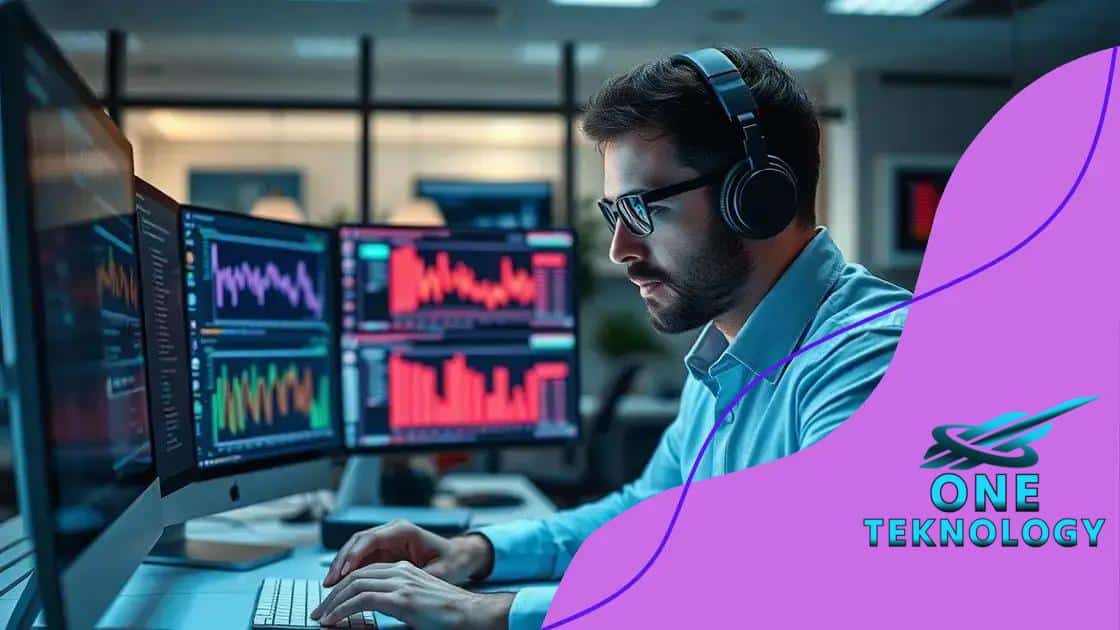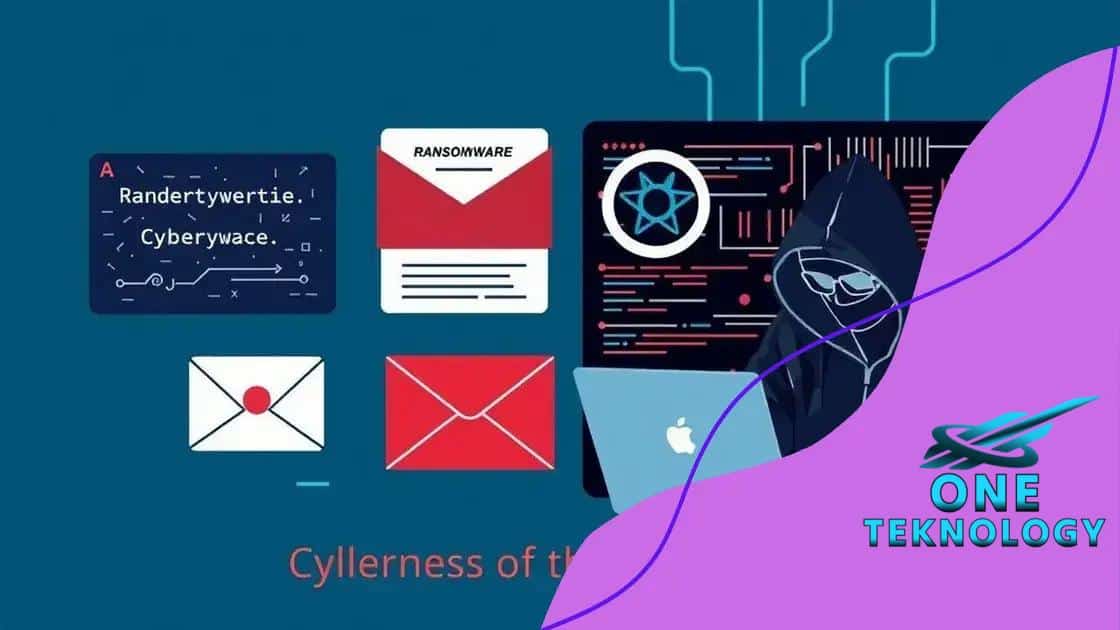Cybersecurity trends and the rise of AI-driven protection

The future of AI in enhancing cybersecurity includes predictive analytics, automation of security processes, and advanced user authentication methods that protect against evolving cyber threats effectively.
Cybersecurity trends and the rise of AI-driven protection are at the forefront of modern technology discussions. As cyber threats evolve, businesses must adapt quickly. Have you considered how AI can transform your security measures?
Understanding the landscape of cybersecurity
Understanding the landscape of cybersecurity is vital in today’s digital world. With the rise of technology, the threats to data and online assets have increased significantly. Companies must grasp the current trends to protect themselves.
Key Components of Cybersecurity
Several aspects define the cybersecurity landscape:
- Network security: Protecting the integrity of networks from intruders.
- Application security: Ensuring applications are safe from threats.
- Endpoint security: Securing end-user devices like laptops and smartphones.
- Data protection: Safeguarding sensitive information from unauthorized access.
Recognizing these key components helps organizations implement effective security measures. As attacks evolve, staying informed about new vulnerabilities is crucial. The cybersecurity landscape includes various types of threats, ranging from phishing to ransomware.
Types of Cyber Threats
Some common threats are:
- Phishing attacks: Deceptive emails that trick users into revealing personal information.
- Malware: Malicious software designed to damage or disrupt systems.
- Denial-of-Service (DoS) attacks: Overloading a service to make it unavailable.
Understanding these threats allows businesses to take a proactive approach. Investing in cybersecurity technologies can greatly reduce risks. Technologies like firewalls, antivirus software, and encryption are essential components of any cybersecurity strategy.
By recognizing the importance of a robust cybersecurity framework, organizations can better withstand potential attacks. The landscape is constantly shifting, presenting new challenges and opportunities. Engaging in regular assessments and updates to security practices will ensure comprehensive protection and readiness against evolving cyber threats.
Key AI technologies shaping protection
Key AI technologies shaping protection are crucial for enhancing cybersecurity. These technologies help businesses defend against complex cyber threats effectively. Understanding how they work can empower organizations to take a proactive stance.
Machine Learning Algorithms
Machine learning algorithms enable systems to learn from data and improve over time. They analyze vast amounts of data to identify patterns. This capability is vital for detecting unusual activities in network traffic.
- Behavioral analysis: It helps in identifying deviations from normal user behaviors.
- Anomaly detection: Detects unusual activity that may indicate a threat.
- Automated responses: Triggers security measures automatically when threats are identified.
By employing machine learning, companies can respond faster to potential breaches. Moreover, these algorithms can continuously adapt, helping organizations stay ahead of evolving threats.
Natural Language Processing (NLP)
Natural Language Processing is another transformative technology. It helps in analyzing and understanding user interactions. By examining communication patterns, organizations can spot phishing attempts and social engineering attacks more effectively.
- Text analysis: Scrutinizes emails and messages for malicious intent.
- Sentiment analysis: Identifies potentially harmful or deceptive communication.
- Contextual understanding: Enhances threat detection by understanding the context of conversations.
Incorporating NLP tools can significantly enhance awareness of security threats. These technologies protect not just the data but also the very human elements involved in cybersecurity.
As businesses leverage these AI technologies, they build stronger defenses against unseen challenges. Approaches like predictive analytics and real-time monitoring further strengthen security measures.
Continuous investment in AI-driven tools will undoubtedly shape the future of cybersecurity. Staying informed about these technologies will help organizations safeguard their assets and maintain trust in their operations.
Top cybersecurity threats in 2023

In 2023, several cybersecurity threats have emerged as critical challenges for organizations worldwide. Understanding these threats is essential for effective protection strategies. By being aware of the landscape, companies can better safeguard their assets.
Ransomware Attacks
Ransomware has continued to rise as a prevalent threat. Attackers use malicious software to encrypt files, demanding payment for decryption. This type of attack can severely disrupt business operations and lead to data loss.
- Increased targeting: Ransomware is increasingly targeting small and medium-sized businesses.
- Double extortion: Attackers not only encrypt files but also threaten to leak sensitive data.
- Evolving tactics: Ransomware groups are deploying new methods to bypass security systems.
Organizations need to implement robust backup solutions and employee training to mitigate this threat. Regularly updating software and employing strong security protocols are also crucial defenses.
Phishing Scams
Phishing scams remain common, tricking users into divulging personal information. Attackers typically use fake emails, texts, or websites designed to look legitimate. This manipulation can lead to identity theft and significant financial loss.
- Email phishing: Attackers send emails that appear to be from trusted sources.
- SMS phishing (smishing): Messages via SMS can also be used to deceive users.
- Voice phishing (vishing): Attackers may call victims to obtain sensitive information.
Awareness training is vital for employees to recognize these threats. Solutions like email filtering also help in identifying suspicious communications before they reach users.
Supply Chain Attacks
Supply chain attacks involve compromising a third-party vendor to gain access to another organization’s data. This type of attack can be especially damaging as it targets trusted partners within business networks.
- Interconnected systems: Attackers exploit vulnerabilities in widely-used software.
- Broader impact: A single breach can affect numerous companies within the supply chain.
- Heightened security scrutiny: Organizations must assess their vendors’ security practices.
Implementing stringent vendor management processes can help organizations reduce these risks. Regular security assessments and audits are critical to ensure all partners maintain high-security standards.
As the cybersecurity landscape evolves, staying informed about these top threats is essential for any organization. Proactive measures, such as continuous monitoring and threat intelligence, can help defend against these challenges effectively.
Best practices for implementing AI solutions
Implementing AI solutions effectively requires careful planning and best practices. Organizations need to approach AI adoption strategically to ensure success. Understanding these best practices can make a significant difference in outcomes.
Define Clear Objectives
The first step in implementing AI solutions is establishing clear objectives. Organizations should identify specific goals they want to achieve with AI. This clarity helps in selecting the right technologies and aligning them with business needs.
- Focus on problems: Understand the challenges you aim to solve with AI.
- Set measurable goals: Define success metrics to evaluate AI performance.
- Prioritize initiatives: Choose projects with high impact and feasibility.
By having clear goals, companies can guide their AI journey more effectively. Teams can focus their efforts on projects that align with strategic objectives, ensuring resources are used wisely.
Invest in Quality Data
Data quality is essential for successful AI implementation. AI algorithms rely on accurate and representative data to function properly. Therefore, investing in data collection and management is crucial for effective solutions.
- Data cleaning: Regularly check and cleanse data for accuracy.
- Diverse data sources: Collect data from various reliable sources to enhance model performance.
- Real-time data collection: Utilize systems that gather data continuously for up-to-date insights.
High-quality data leads to better AI outcomes. Organizations must establish robust processes for data governance to maintain data integrity.
Build Cross-Functional Teams
Successful AI projects require collaboration across various functions. Involve teams from different departments, including IT, operations, and business management, to leverage diverse expertise.
- Encourage collaboration: Foster teamwork among data scientists, developers, and business leaders.
- Promote knowledge sharing: Organize workshops and training sessions to enhance skills across teams.
- Establish clear roles: Define responsibilities to avoid confusion during implementation.
Collaboration helps ensure that AI solutions are aligned with organizational needs and technical requirements. When different perspectives come together, they can drive more innovative and effective solutions.
Additionally, monitoring and refining AI solutions over time will help maintain their effectiveness. Continuous evaluation and feedback loops are crucial to adapting technology as business needs evolve.
The future of AI in enhancing cybersecurity
The future of AI in enhancing cybersecurity looks promising. As technology evolves, AI continues to play a pivotal role in protecting organizations from cyber threats. Understanding future trends can help businesses prepare for what lies ahead.
Predictive Analytics
One key area where AI will significantly impact cybersecurity is through predictive analytics. By analyzing vast amounts of data, AI can forecast potential threats before they occur. This proactive approach allows organizations to strengthen defenses and address vulnerabilities.
- Threat identification: Identifying potential breaches before they impact systems.
- Incident response: Improving response times to security incidents.
- Resource allocation: Allowing better allocation of security resources based on predicted threats.
With predictive analytics, organizations can move from a reactive to a proactive security stance, enhancing overall cybersecurity posture.
Automation of Security Processes
AI is also expected to automate many security processes, reducing the burden on IT teams. Automation can help streamline tasks such as monitoring, threat detection, and incident response.
- Automated monitoring: Enhancing surveillance of networks to detect anomalies.
- Threat hunting: Allowing AI to search for threats efficiently.
- Incident remediation: Enabling faster recovery from attacks with automated responses.
By automating repetitive tasks, organizations can focus more on strategic initiatives and less on manual processes, improving efficiency while bolstering security.
Enhanced User Authentication
Another future trend is the enhancement of user authentication methods through AI. Traditional password systems are becoming less secure, pushing organizations to adopt more advanced techniques such as biometric authentication.
- Facial recognition: Utilizing AI to recognize and authenticate users based on facial features.
- Behavioral analytics: Analyzing user behavior patterns to identify abnormalities.
- Multi-factor authentication: Combining several authentication methods for increased security.
These advancements can significantly reduce unauthorized access and increase trust in digital systems.
As AI technology continues to advance, it will undoubtedly reshape the cybersecurity landscape. Staying informed about these developments will help organizations better prepare for future challenges and improve their security measures.
In conclusion, the future of AI in enhancing cybersecurity holds great promise. By leveraging technologies like predictive analytics, automation, and advanced authentication methods, organizations can stay one step ahead of cyber threats. Embracing these innovations will not only improve security measures but also foster trust among users. As AI continues to evolve, it will play a crucial role in shaping the landscape of cybersecurity, making it essential for businesses to keep pace with these advancements.
\n\n
\n
FAQ – Frequently Asked Questions about AI in Cybersecurity
What is predictive analytics in cybersecurity?
Predictive analytics uses AI to analyze data trends and forecast potential threats, enabling organizations to act before issues arise.
How does AI automate security processes?
AI automates repetitive tasks such as monitoring and threat detection, allowing IT teams to focus on more strategic responsibilities.
What are the benefits of enhanced user authentication?
Enhanced user authentication, such as biometric verification, improves security by ensuring that only authorized personnel can access sensitive information.
How can businesses prepare for future cyber threats using AI?
Businesses can stay proactive by investing in AI technologies, continuously monitoring systems, and updating security measures based on the latest trends.






